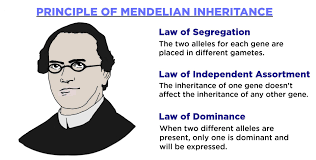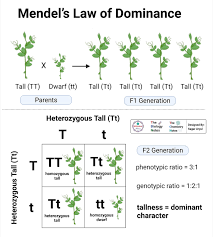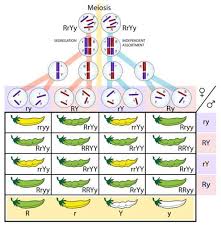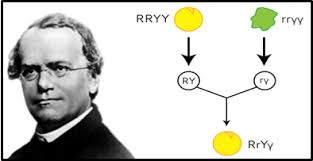This article explores the fundamental concepts of Mendelian genetics, focusing on Gregor Mendel’s experiment and the key findings that form the foundation of inheritance studies. The article will explain Mendel’s first law in detail and discuss the basic calculations related to the monohybrid ratio of 1:3.
Mendelian Theory and the Fundamental Principles of Genetics

Modern genetics owes its development to Gregor Johann Mendel, a German-Czech Augustinian monk who studied the inheritance of traits in plants. In his 1865 paper, Experiments on Plant Hybridization, Mendel explored the inheritance patterns of traits in pea plants and outlined them mathematically.
While his work was initially underappreciated, it gained recognition after the 1890s when other scientists rediscovered his research.
At its core, inheritance in organisms occurs through discrete traits, known as genes. Mendel’s research revealed that traits in pea plants, such as flower color, were inherited in a particulate manner.
These traits, which exist as different versions known as alleles, are passed down from parents to offspring. For each gene, a plant inherits one allele from each parent, leading to combinations of alleles that determine the plant’s genotype. Organisms with identical alleles are homozygous, while those with different alleles are heterozygous.
In heterozygous organisms, one allele often dominates the phenotype, while the other remains recessive. Some alleles exhibit incomplete dominance or codominance, producing intermediate or dual phenotypes. During sexual reproduction, offspring inherit one allele from each parent at random.
Dominance and Recessiveness in Mendelian Genetics
Dominance refers to the interaction between alleles where one allele completely masks the expression of the other, which is called recessive. Complete dominance occurs when both heterozygotes and dominant homozygotes show the same phenotype.
For instance, in some poultry breeds, the gene for white skin (WW) dominates the gene for yellow skin (ww), resulting in all offspring having white skin, though they are heterozygous.
The Law of Dominance explains that, in a cross between parents with contrasting traits (such as Y for yellow and y for green), only the dominant form will appear in the offspring. All offspring will be heterozygous and exhibit the dominant trait.
Read Also: Considerations and Requirements for Rabbit Housing
Mendel’s First Law (The Law of Segregation)

Mendel’s first law, known as the Law of Segregation, states that “two members of a gene pair segregate from each other into the gametes, so that half of the gametes carry one member of the pair and the other half carry the other member of the pair.
This means that, during gamete formation, alleles for a given trait separate and recombine at fertilization to form the offspring’s genotype.
Monohybrid Crossing: A Study of Single Trait Inheritance
A monohybrid cross focuses on a single trait, such as flower color. Mendel began his experiments by producing pure strains of pea plants through self-pollination.
He examined eight contrasting traits and crossbred true-breeding tall plants (TT) with dwarf plants (tt). The F1 generation consisted entirely of tall plants, demonstrating that the tall allele (T) was dominant.
When F1 plants were self-pollinated, Mendel observed that the resulting F2 generation exhibited a 3:1 ratio—three-quarters of the plants were tall, while one-quarter were dwarf.
Read Also: The Recommended Feeding Pattern for Rabbit Kits
Summary of Mendel’s Monohybrid Cross Experiment
| Parental Phenotype | Tall | Dwarf |
|---|---|---|
| Parental Genotype (2n) | TT × tt | |
| Gametes (n) | T | t |
| F1 Genotype (2n) | Tt | |
| Phenotype | All Tall | |
| F2 Genotype (2n) | TT, Tt, tt | |
| Genotypic Ratio | 1 TT : 2 Tt : 1 tt | |
| Phenotypic Ratio | 3 Tall : 1 Dwarf |
Mendel’s Second Law (The Law of Independent Assortment)

Mendel’s second law, the Law of Independent Assortment, states that “gene pairs assort independently during gamete formation.” This means that alleles for different traits are distributed to sex cells and offspring independently of one another.
The Dihybrid Cross is used to illustrate this law by studying the inheritance of two traits, such as flower color and plant height.
In a dihybrid cross, two parent plants differing in two traits are crossed. Mendel used this method to investigate whether traits like flower color and seed shape were inherited independently.
The Punnett square is a tool used to predict the probability of offspring traits, showing all possible combinations of alleles. For example, a cross between pure-breeding round yellow peas (RRYY) and wrinkled green peas (rryy) would result in F1 seeds that are round and yellow (RrYy).
When these F1 plants are self-pollinated, the resulting F2 generation will display a variety of combinations of the traits.
Punnett Square for Dihybrid Cross
| Gametes | RY | Ry | rY | ry |
|---|---|---|---|---|
| Gametes (RRYY × rryy) | ||||
| F1 Genotype | RrYy |
Do you have any questions, suggestions, or contributions? If so, please feel free to use the comment box below to share your thoughts. We also encourage you to kindly share this information with others who might benefit from it. Since we can’t reach everyone at once, we truly appreciate your help in spreading the word. Thank you so much for your support and for sharing!

